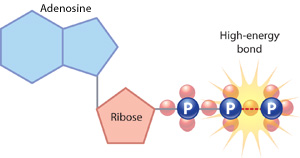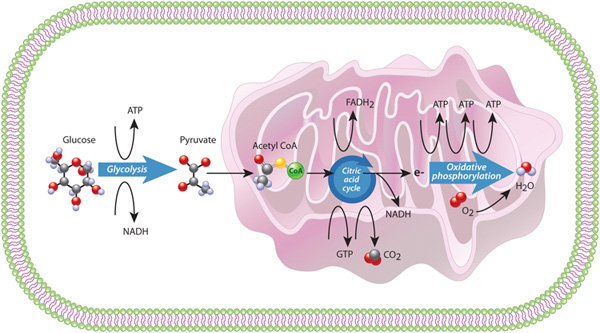Energy From Organic Molecules Can Be Stored in Atp Molecules as a Direct Result of the Process of

Figure 5: An ATP molecule
ATP consists of an adenosine base (blue), a ribose sugar (pinkish) and a phosphate chain. The high-energy phosphate bail in this phosphate chain is the fundamental to ATP'due south energy storage potential.
The particular energy pathway that a cell employs depends in big part on whether that jail cell is a eukaryote or a prokaryote. Eukaryotic cells utilize iii major processes to transform the energy held in the chemic bonds of food molecules into more readily usable forms — often energy-rich carrier molecules. Adenosine 5'-triphosphate, or ATP, is the nigh arable energy carrier molecule in cells. This molecule is made of a nitrogen base (adenine), a ribose saccharide, and three phosphate groups. The word adenosine refers to the adenine plus the ribose sugar. The bail between the 2nd and third phosphates is a high-energy bail (Figure 5).
The beginning process in the eukaryotic energy pathway is glycolysis, which literally means "sugar splitting." During glycolysis, unmarried molecules of glucose are split and ultimately converted into two molecules of a substance called pyruvate; because each glucose contains six carbon atoms, each resulting pyruvate contains just three carbons. Glycolysis is actually a series of x chemic reactions that requires the input of 2 ATP molecules. This input is used to generate four new ATP molecules, which means that glycolysis results in a net proceeds of two ATPs. 2 NADH molecules are also produced; these molecules serve equally electron carriers for other biochemical reactions in the cell.
Glycolysis is an ancient, major ATP-producing pathway that occurs in well-nigh all cells, eukaryotes and prokaryotes alike. This process, which is as well known as fermentation, takes place in the cytoplasm and does not require oxygen. All the same, the fate of the pyruvate produced during glycolysis depends upon whether oxygen is present. In the absenteeism of oxygen, the pyruvate cannot be completely oxidized to carbon dioxide, and then various intermediate products upshot. For example, when oxygen levels are low, skeletal muscle cells rely on glycolysis to come across their intense free energy requirements. This reliance on glycolysis results in the buildup of an intermediate known every bit lactic acrid, which can crusade a person'southward muscles to experience as if they are "on fire." Similarly, yeast, which is a unmarried-celled eukaryote, produces alcohol (instead of carbon dioxide) in oxygen-deficient settings.
In contrast, when oxygen is available, the pyruvates produced by glycolysis become the input for the next portion of the eukaryotic free energy pathway. During this stage, each pyruvate molecule in the cytoplasm enters the mitochondrion, where it is converted into acetyl CoA, a 2-carbon free energy carrier, and its 3rd carbon combines with oxygen and is released equally carbon dioxide. At the same time, an NADH carrier is as well generated. Acetyl CoA then enters a pathway called the citric acrid bicycle, which is the 2nd major energy process used by cells. The eight-pace citric acrid cycle generates iii more NADH molecules and ii other carrier molecules: FADHtwo and GTP (Figure vi, centre).

Figure 6: Metabolism in a eukaryotic prison cell: Glycolysis, the citric acid cycle, and oxidative phosphorylation
Glycolysis takes place in the cytoplasm. Inside the mitochondrion, the citric acid bike occurs in the mitochondrial matrix, and oxidative metabolism occurs at the internal folded mitochondrial membranes (cristae).
The 3rd major process in the eukaryotic energy pathway involves an electron send chain, catalyzed by several poly peptide complexes located in the mitochondrional inner membrane. This process, called oxidative phosphorylation, transfers electrons from NADH and FADHii through the membrane protein complexes, and ultimately to oxygen, where they combine to form water. As electrons travel through the protein complexes in the concatenation, a slope of hydrogen ions, or protons, forms beyond the mitochondrial membrane. Cells harness the energy of this proton gradient to create 3 additional ATP molecules for every electron that travels forth the chain. Overall, the combination of the citric acrid bike and oxidative phosphorylation yields much more than energy than fermentation - xv times every bit much energy per glucose molecule! Together, these processes that occur within the mitochondion, the citric acid cycle and oxidative phosphorylation, are referred to as respiration, a term used for processes that couple the uptake of oxygen and the product of carbon dioxide (Figure 6).
The electron transport chain in the mitochondrial membrane is not the only one that generates energy in living cells. In plant and other photosynthetic cells, chloroplasts besides take an electron send concatenation that harvests solar energy. Even though they practise non contain mithcondria or chloroplatss, prokaryotes accept other kinds of energy-yielding electron transport bondage inside their plasma membranes that also generate energy.
Source: https://www.nature.com/scitable/topicpage/cell-energy-and-cell-functions-14024533/
0 Response to "Energy From Organic Molecules Can Be Stored in Atp Molecules as a Direct Result of the Process of"
Post a Comment